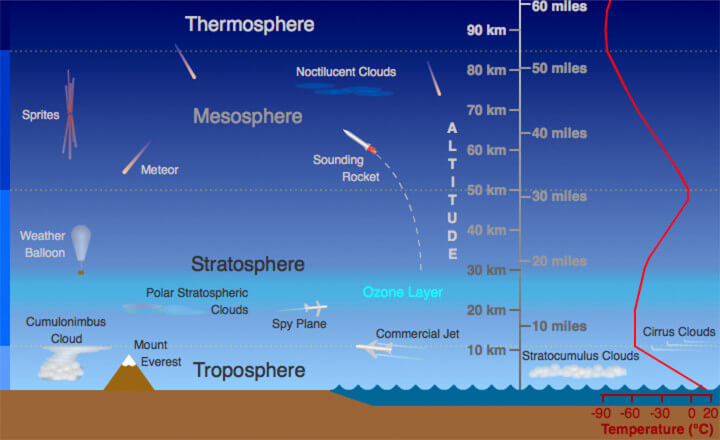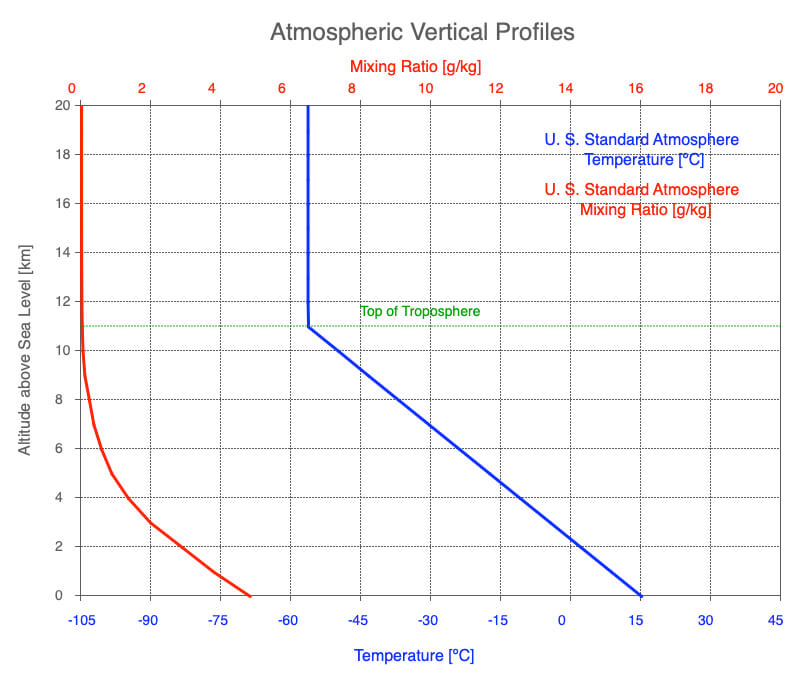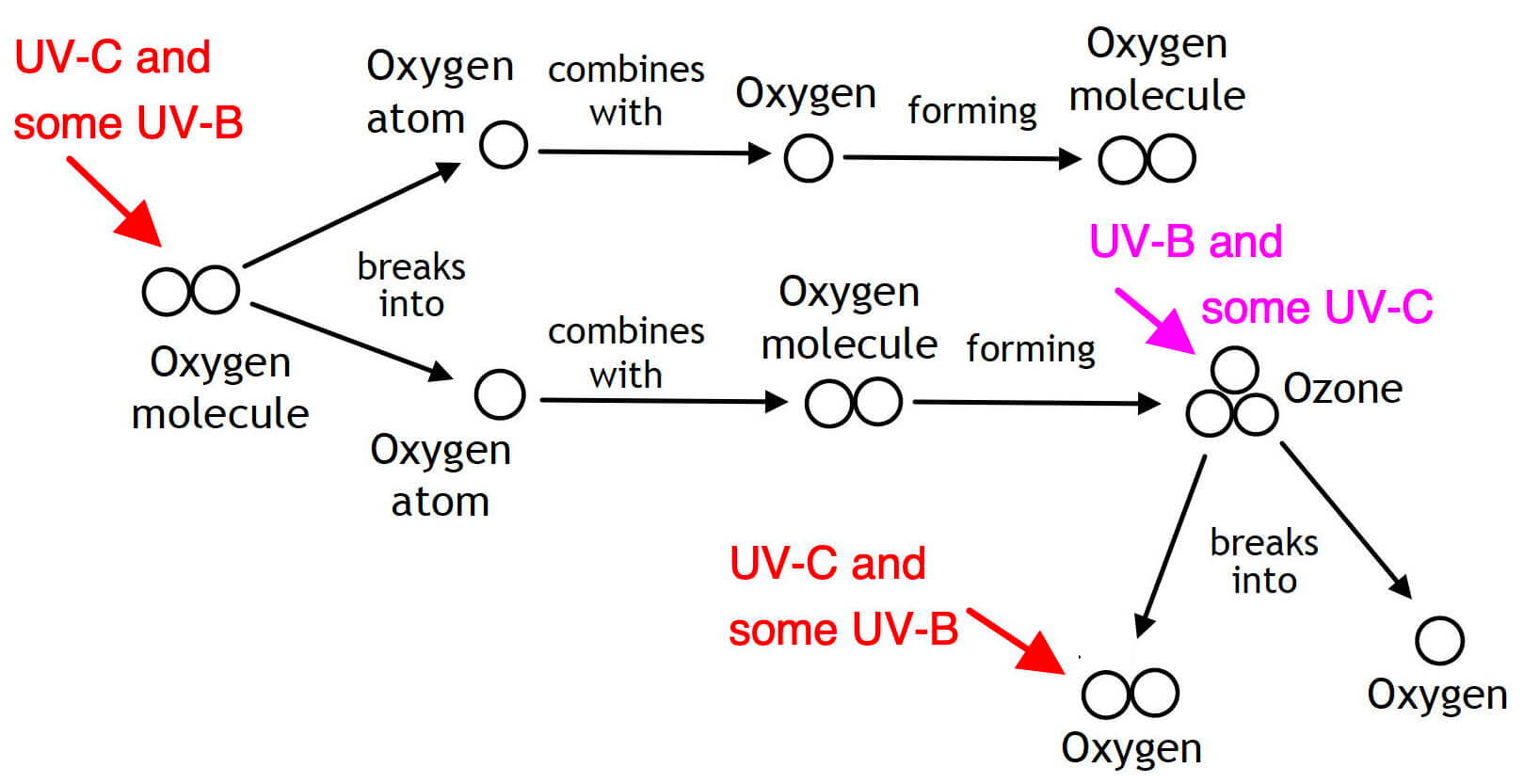← Greenhouse Gases | Clouds →
Atmospheric Layers
The heat transfer processes, conduction, radiation, advection, convection, and latent heat (CRACL), drive atmospheric processes. The behavior of Earth’s atmosphere is not uniform with height due to interactions with the Sun’s radiant energy, the daily and seasonal heating patterns of the Earth’s surface, and the availability of liquid water at the Earth’s surface. Instead, there are layers defined by how temperature changes with height (See the diagram of Earth’s atmospheric layers. Credit: Randy Russell, UCAR).
Note: air density must always decrease upward. If not, the less dense air will rise vertically to a level where it is the same density as its surroundings.

Troposphere
Since Earth’s atmosphere is mostly transparent to the Sun’s thermal radiation, the Earth’s surface receives most of the incoming sunlight. The absorbed radiation heats the surface during the day. The net loss of thermal radiation at night cools the surface. The surface temperature affects the temperature of the layer of air next to the Earth’s surface: the Troposphere. Since the air next to the ground tends to heat during the day time when the ground is warming, it may become less dense than the surrounding air and rise. As we see in the Clouds section, rising air expands since air pressure decreases, which makes the rising air cool. Combining the two processes, most of the heating of the troposphere occurs at the Earth’s surface. The warmed air rises and cools as it expands. The result is that temperature decreases with height on average at a rate of 6.5ºC/km throughout the troposphere.
The largest reservoir of water, the oceans, lies at the base of the atmosphere. The oceans are the primary source of water vapor through evaporation, so the highest concentration of water vapor is in the lowest layer of the atmosphere. Rising humid air drives our day-to-day weather events, so we will focus on the troposphere to understand the water cycle.
Explore The Properties of the Troposphere
Use the desktop app, Atmosphere, Clouds, and Precipitation, to study the seasonal changes and latitudinal differences of the troposphere. Go to the Software page to download a version for Macs or PCs.

Average vertical temperature and mixing ratio (grams of water vapor to grams of kg of dry air) for the troposphere into the lower stratosphere. Graph created using the Atmosphere, Clouds, and Precipitation software. Use it to interactively explore the seasonal and latitudinal effects on atmospheric variables with height.
Stratosphere
The atmosphere is not entirely transparent to the Sun’s radiation. It turns out oxygen and ozone absorb deadly ultraviolet in the Stratosphere. Based on the Sun’s surface temperature, it emits a broad spectrum of electromagnetic radiation, spanning predominantly from the ultraviolet to far-infrared (see Radiation). Photons (massless packets of radiant energy) don’t have the same amount of energy – it depends on its wavelength. Visible light and shorter wavelengths are energetic enough to break apart molecules, known as photodissociation. An example is photosynthesis in plants.
The warm stratosphere stops rising air from leaving the troposphere. This ceiling forms our large-scale atmospheric circulation patterns that create deserts and rainforests globally.
Evolution of the Stratosphere
The stratosphere requires that the atmosphere must contain sufficient oxygen levels (a minimum of 10%). But oxygen in Earth’s atmosphere slowly developed as photosynthesizing plants evolved and eventually thrived.
Prior to the formation of the stratosphere, there wasn’t a low-density ceiling capping the troposphere. As you explore the Clouds and Precipitation sections, consider what weather systems may have been like before the stratosphere formed roughly a billion years ago.
The Sun’s UV Creates the Stratosphere
There are three bands of ultraviolet: UV-C with the shortest wavelengths (and most energetic photons), UV-B and UV-A. UV-C is deadly to most living organisms, UV-B causes DNA damage to living cells, and UV-A causes wrinkles and premature aging of human skin.

Oxygen (O2), ozone (O3), and life-damaging UV create a self-generating system that protects life on Earth:
- UV-C and UV-B (upper end) -> absorbed by O2 to create two O
- O2 + O -> O3 + heat
- UV-C and UV-B -> absorbed by O3 to create O2 + O
Mesosphere
The mesosphere’s temperature decreases with height. It is the least observed layer of our atmosphere.
Thermosphere
The thermosphere is the least dense and the disperse molecules absorb the Sun’s x-rays and some UV-C so its temperature increases with height.
For Earth Systems, we will focus on the weather created in the troposphere and the absorption of UV in the stratosphere.
← Greenhouse Gases | Clouds →

0 Comments